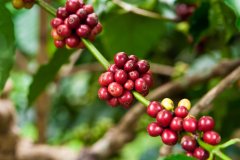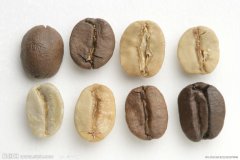Kenyan Kenya AA Coffee Kenyan Coffee beans mocha Coffee
This classification method is based on a variety of perforated screen classification, the screen has a variety of specifications, identified by the number, the number is associated with the mesh. The size of the mesh-1 stroke 64 inches is the unit of calculation. If the diameter of the mesh is 18 stroke 64 inches, the number of the screen is 18; if the diameter of the mesh is 17 inch 64 inches, the number of the screen is 17. And so on, there are 19, 16, 15, 14 and other numbered screens.
The process of screening is to put the coffee beans on the Internet and shake them back and forth by machine or manually, and the beans smaller than the mesh will fall and be removed, and the beans that have been rejected will be screened through a smaller screen. After layers of screening, the grades of coffee beans are compiled.
After classification, it is divided into AA, A, B, C and PB series. AA is the highest, A, B and C decrease in turn, and those below C are usually used as feed or fertilizer. In addition, round beans have a special flavor, and beans are already relatively small, so they have their own grade, that is, "PB", which is usually more expensive. This classification is generally used in Kenya, New Guinea, Puerto Rico, Zimbabwe, Tanzania and Uganda.
◎ is graded by the number of defective beans.
This is the earliest method of classification and is still in use in many parts of Brazil. The method of identification is to randomly take 300 grams of samples and put them on black paper, because black paper can best avoid reflection. Then, examined carefully by the professional appraiser, find out the defective beans in the sample, and accumulate different scores according to the types of defects. For example, one black bean, one pebble, five big pebbles, five broken beans, five pest beans, two sour beans, one dry peel, two middle dried peels, three small dried peels, five unshelled beans, three shell beans, and so on. After identification, the grade is NY2~NY8 according to the accumulated defect score, and there is no NY1. If you want to buy first-class (NY1) Brazilian beans, it will make a joke. Indonesian coffee beans are also classified in this way, mainly divided into six grades, namely Gr1~Gr6. The same is true of Ethiopia, with the highest level being Gr2.
◎ is highly classified by place of origin
Generally speaking, in alpine areas, due to the cold climate and the slow growth rate of coffee, the density of raw beans is higher and the texture is harder, and the more mellow and aromatic the coffee is, and it has a supple sour taste; on the contrary, the density of raw beans is smaller and the texture is less hard, then the quality of coffee is worse, so there are also people who classify it as "hardness". This classification method can be divided into the following categories: extremely hard beans, height of about 4500 to 5000 feet, referred to as SHB; high hard beans, height of about 3000cm 4500ft, referred to as GHB; hard beans, height of about 2000,000ft, referred to as HB; Pacific coastal area, height of about 984ft 3280ft, referred to as Pacific. Guatemala, Costa Rica, El Salvador, Mexico, Honduras and Haiti are all classified in this way. In this cold season, whether it's working hard in the office or watching a play on the couch at home, it couldn't be better to have a cup of warm coffee in your hand. Coffee production has plummeted as a result of weather and disease in coffee-producing Brazil. Starbucks, the world's largest coffee chain, has turned its attention to the Chinese market.
As the world's largest coffee chain, Starbucks imported nearly 14000 bags of Arabica coffee beans from China into the United States in the first nine months of this year, more than five times the total imported last year. Starbucks' imports of coffee beans from China have soared this year, reflecting the growth of its retail business in China. In 2013, Starbucks imported less than 2600 bags of coffee beans from China, and one bag weighed 60 kilograms.
According to the China Food and Beverage Network reporter, Starbucks and Nestle and other enterprises have set up coffee bean procurement sites in Yunnan, China. Volcafe, the US food company, has also said it will set up a branch in Yunnan, China, to buy and sell coffee beans, marking the growing global popularity of the Chinese coffee bean market.
Emerging markets with faster coffee growth, such as China and Russia, will grow at an average annual rate of 4% to 4.5%, while traditional markets will grow by 1% to 1.5%. Yunnan is unlikely to catch up with Minas Gerais in Brazil, the world's number one coffee producer, in terms of coffee production. But in the face of drought and disease threatening coffee production in Brazil and Central America, some roasters are looking for alternative sources, and Chinese coffee beans can attract buyers.
Important Notice :
前街咖啡 FrontStreet Coffee has moved to new addredd:
FrontStreet Coffee Address: 315,Donghua East Road,GuangZhou
Tel:020 38364473
- Prev

Taiwan coffee beans where can Taiwan grow coffee beans? Taiwan is suitable for growing coffee beans.
Taiwan is located in the subtropics, the territory is mountainous, and there is an obvious rainy season. As far as coffee is concerned, it is a good growing environment. Since the British introduced coffee trees during Guang Xu's time, the planting scale has been small. At present, there are still small-scale cultivation, including Huilin Farm (more than 1,000 meters above sea level) in Nantou Mountain area and Hebao Mountain (294 meters above sea level) in Yunlin Gukeng. The flavor of coffee by-products is similar.
- Next

Brazil accounts for 1% of the world's total coffee production. 3 Brazil grows coffee beans.
Coffee production accounts for 1 / 3 of the world's total. Although it occupies a very important position in the whole coffee market, it is the largest producer. However, because the Brazilian coffee industry has been adopting the strategy of low price and large number of planting, the coffee produced is of average but less excellent quality, which is generally considered to be an indispensable coffee bean in mixing and blending.
Related
- Does Rose Summer choose Blue, Green or Red? Detailed explanation of Rose Summer Coffee plots and Classification in Panamanian Jade Manor
- What is the difference between the origin, producing area, processing plant, cooperative and manor of coffee beans?
- How fine does the espresso powder fit? how to grind the espresso?
- Sca coffee roasting degree color card coffee roasting degree 8 roasting color values what do you mean?
- The practice of lattes: how to make lattes at home
- Introduction to Indonesian Fine Coffee beans-- Java Coffee producing area of Indonesian Arabica Coffee
- How much will the flavor of light and medium roasted rose summer be expressed? What baking level is rose summer suitable for?
- Introduction to the characteristics of washing, sun-drying or wet-planing coffee commonly used in Mantenin, Indonesia
- Price characteristics of Arabica Coffee Bean Starbucks introduction to Manning Coffee Bean Taste producing area Variety Manor
- What is the authentic Yega flavor? What are the flavor characteristics of the really excellent Yejasuffi coffee beans?

